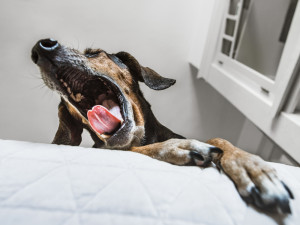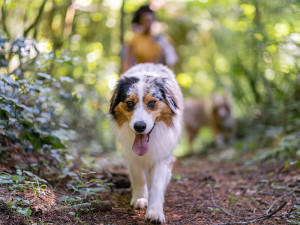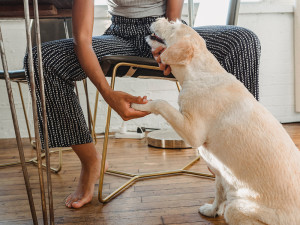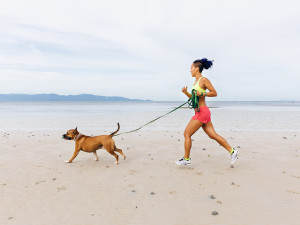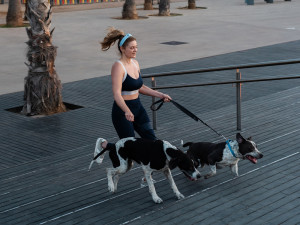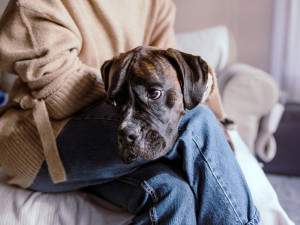Why Is My Dog Panting?
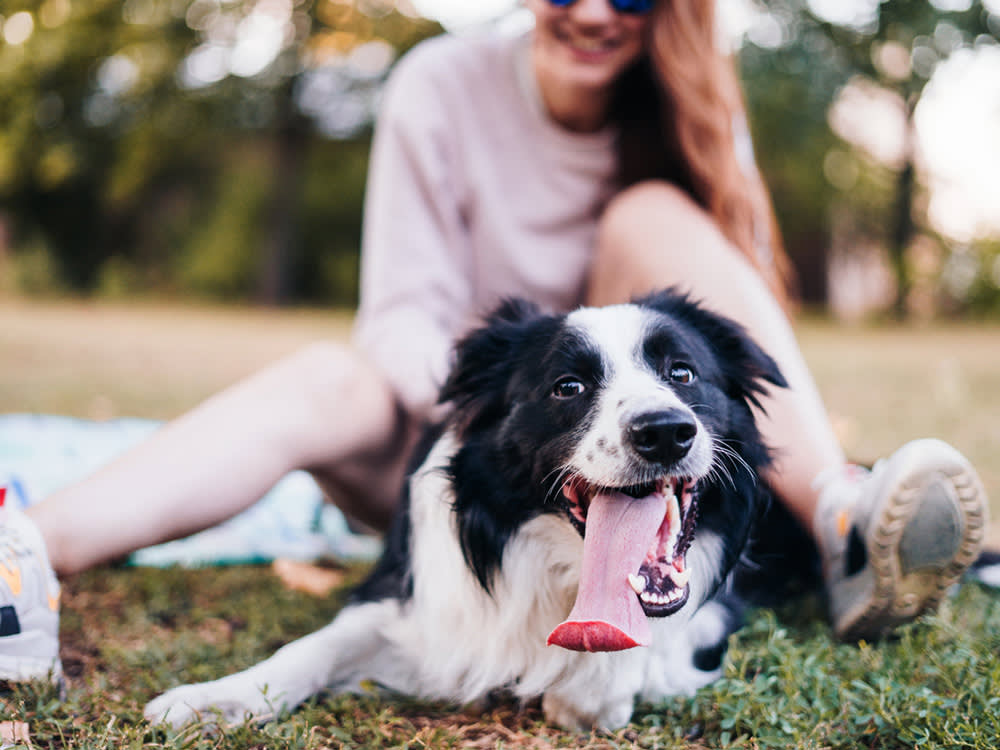
share article

Your pet wants you to read our newsletter. (Then give them a treat.)
In This Article:
What Is Panting?opens in a new tab Why Do Dogs Pant?opens in a new tab How Much Panting Is Abnormal?opens in a new tab Reasons for Excessive Pantingopens in a new tab When to Contact Your Vet About Excessive Pantingopens in a new tab
There’s nothing cuter than dogs frolicking out in the great wide open, running at full speed with their tongues hanging out in what looks like an ear-to-ear grinopens in a new tab. And while we love and expect dogs to pant while they are running around, you may be wondering why your dog seems to be panting at other random times.
Read on to learn all about why dogs pant and when to be concerned.
What is panting?
Panting is a breathing technique that dogs typically use to cool off. A panting dog will have their mouth open, usually with their tongue hanging out, and will be taking frequent, shallow breaths. This is done to quickly move air over the moist surfaces of their respiratory tract, which allows them to cool down.
Panting is the only mechanism dogs have to cool off since they do not sweat like we do. This is why you will often see your dog panting if it is hot out and/or if they are exercising.
Why do dogs pant?
The main reason that dogs pant is to cool off; however, sometimes dogs will also pant for reasons that are unrelated to cooling down. The main reasons dogs will pant include:
Cooling off
Panting is the main way that dogs can cool off so they will often pant as soon as their body temperature starts to climb.
Exertion
Physical exercise of any kind, including runningopens in a new tab, climbing stairs, and wrestling with other dogs can lead dogs to exert themselves. As they exercise, their body temperature rises, and they exert more energy, so they pant to cool down.
Behavioral reasons
Dogs will also pant in certain emotional situations such as when they are excited, stressedopens in a new tab, scared, or nervous. In these cases, they do not actually need to cool off, but this is more of a psychological reaction and may be accompanied by an elevated heart rate and respiratory rate.
Pain
Dogs often pant when they are in painopens in a new tab. This is partially a behavioral response. Pain can also cause physical changes like an elevated heart rate and respiratory rate, which in turn can lead dogs to pant.
Illness
Certain disease processes can also make dogs more likely to pant. This includes any condition where a dog has a fever, as well as conditions that cause an increase in steroid hormones, such as Cushing’s diseaseopens in a new tab.
Medications
Certain medications, including sedatives, steroids, and pain medications, can cause dogs to pant as well.
Respiratory distress
Dogs who are having difficulty breathing may pant or breathe with their mouths open; however, this is not always the case. Other signs of a breathing problem include loud breath noises, rapid breathing, bluish gums and tongue, and/or increased effort to take a breath. Any of these signs are considered medical emergencies.
How much panting is abnormal?
It can be difficult to judge how much panting is abnormal in many cases, because this can differ from one dog to the next. Because panting has a very important purpose for dogs, as long as they are panting at appropriate times, and without any other signs of breathing difficulty or other health problems, it can be normal. This is especially true if they are panting for an obvious reason, such as on a hot day or after exercise.
As long as they stop panting after a reasonable amount of time and are able to settle down, that is most likely a normal response. But it is also important to take heavy panting as a sign that your dog is exerting themself to the max; if you are out for a walk on a hot day, and they are panting hard, that is a sign that they are getting too hot and need to get to a cool spot to rest and have some water.
The same goes for exercise; if your dog is panting heavily and can’t catch their breath, they need a breakopens in a new tab. If you provide them with rest, a cool place to rest and some water and they still continue to pant heavily, this can be a sign of overheating, and you should get to a vet right away.
Reasons for excessive panting
Excessive panting can occur for many different reasons, so it’s important to look for patterns as to when and where your dog is panting and report these patterns to your vet. A dog who is panting excessively should have a full veterinary work-up to look for underlying medical causes including:
Overheating
The most common reason for a dog to pant excessively is due to overheating. This would be especially likely in hot weather, or after intense exercise. Some dogs may have underlying medical problems that lead them to overheat more easily, including obesityopens in a new tab, respiratory problems, and smushed-face breeds known as brachycephalicsopens in a new tab, so they may exhibit these signs even when it doesn’t feel that hot out for us. Overheating can lead to life-threatening heat strokeopens in a new tab so any dog who does not seem to cool off quickly once in a cool place needs to see a veterinarian immediately.
Pain
Pain is another reason dogs may pant, especially if they are at rest, in a cool space. Pain may be obvious if your dog has a sudden injury. In other cases, dogs may be very stoic and not show clear signs of pain. This is especially common with more chronic forms of pain, such as arthritis.opens in a new tab
Respiratory disease
Dogs with respiratory disease don’t always pant, but some might, especially if their underlying respiratory disease makes them overheat. Other common signs of respiratory disease include getting tired quickly, breathing fast, using more effort to take a breath, a blue tinge to the gums and tongue, coughingopens in a new tab, collapse, and/or loud breathing noises. All of these signs indicate a medical emergencyopens in a new tab.
Cardiovascular disease
Heart disease opens in a new taband respiratory disease are often interconnected, so dogs with heart disease may have difficulty breathing, too. Not every dog with heart disease will pant, but some might. They may also show signs similar to a dog with respiratory disease including getting tired quickly, breathing fast, using more effort to take a breath, a blue tinge to the gums and tongue, coughing, collapse, and/or loud breathing noises.
Behavioral issues
Excessive panting is caused by many reasons, including emotional reasons including excitement, anxiety, fear, or stress. If your dog has other signs of a behavioral condition, this may be the reason for their panting, but it’s important to have a full medical work-up first to rule out any of the more serious health problems. If your dog seems to pant excessively and has other signs of anxiety or fear, get them help and relief from these feelings. This may involve both behavioral-modification training as well as medications.
When to contact a vet about excessive panting
If you believe your dog is panting excessively, always contact your vet. It is important to check for serious medical problems that could be causing them to pant so much and get your dog relief, if needed. Even if you believe your dog is panting due to behavioral reasons, there are ways to help them feel better and avoid those intense feelings.
Finally, if your dog has any other signs of illness or pain, including decreased appetite, vomiting or diarrhea, lethargy, breathing fast, using more effort to take a breath, a blue tinge to the gums and tongue, coughing, collapse, and/or loud breathing noises, these are all signs of a more serious problem and should be checked out right away.
How is excessive panting in dogs treated?
Excessive panting does not need to be treated directly, but rather, the underlying causes leading to the panting need to be diagnosed and treated. Your vet will perform a thorough physical exam as well as additional tests like bloodwork and X-rays in order to help determine the cause of your dog’s panting.
Based on these findings, your vet will treat any underlying medical problems that are discovered. If your dog is panting due to overheating, they will need to be actively cooled and given supportive care like intravenous fluids to help stabilize them. In extreme cases of heat stroke, dogs often need intensive care in the hospital to get them through the most serious complications.
Other conditions that may lead to panting like pain, fevers, respiratory disease, or heart disease are treated specifically based on the diagnosis. More serious conditions, especially those related to breathing often require hospitalization and more intensive support. Your vet will council you on the best course of action for your dog’s specific condition.
How to manage panting at home
If you are concerned that your dog is panting excessively, especially if they also have other signs of illness or distress, head to the vet right away and don’t try to manage this issue at home. The more serious causes for excessive panting are true medical emergencies and early intervention could save your pup’s life. In cases where your dog is panting but acting fine otherwise, you should focus on keeping your dog cool and calm. Because overheating is a common cause for panting, be sure to give your dog a nice cool place to hang out that is quiet and has access to water.
If your dog was just out in the heat or just finished exercising, you can actively cool them down by wetting their fur with cool or room-temperature water and aiming a fan at them. If they are panting due to fear, anxiety or stress, try to find a quiet safe space for them away from any stimulation where they can settle down. If you have a pheromone diffuser opens in a new tabor spray, you can bring that into the quiet space to help soothe your dog, too. If they do not respond to these measures and continues to pant excessively or develop any other concerning signs, head to the vet.
If you have already been to the vet and know your dog always pants excessively in certain situations, speak with your vet about long-term strategies to manage this. For behavioral causes, you can work with a behavioristopens in a new tab to implement a training plan to help them cope with scary or overwhelming situations. For some dogs, a combination of training and medication is most effectiveopens in a new tab to bring them relief. That way, if you can anticipate stressful situations like fireworks, travel, or whatever triggers your pup, you can be proactive in your approach and avoid a crisis.
FAQs (People also ask):
Why is my dog breathing heavily but not panting?
Breathing heavily without panting can be a sign of a respiratory problem, a heart problem, or other serious illness. Any dog breathing heavily needs to get to a vet right away.
Are there differences between male and female dogs and panting levels?
In general, there are no gender differences regarding panting levels. Female dogs will pant more if they are in advanced pregnancy, however.
How can I tell if my dog’s breathing is normal?
At rest, a dog’s respiratory rate should be less than 20 breaths per minute, with sleeping dogs closer to eight to 12 breaths per minute. If your dog is breathing more quickly and/or has other signs of distress such as getting tired quickly, using more effort to take a breath, a blue tinge to the gums and tongue, coughing, collapse, and/or loud breathing noises, these are all cause for concern.
References:

Dr. Amy Fox, DVM
Amy Fox, DVM is a small animal veterinarian in New York City. A lifelong animal lover, Dr. Fox studied biology in college and then worked as a veterinary nurse before pursuing veterinary school at Cornell University. She has worked in many different settings including shelter medicine, emergency medicine, general practice, and animal cruelty and forensics. She is especially interested in nutrition, preventative medicine and care for senior pets. Dr. Fox also enjoys writing about veterinary medicine and teaching. In her free time she loves to cook, garden, and go for long runs.
Related articles
![Woman holding a beagle in warm dappled summer light]() opens in a new tab
opens in a new tabYou’ve Got a Summer-Lovin’ Pup. Here’s How to Keep Them Safe
Some like it hot (but not most dogs). Here are the season’s health hazards, from fleas to foxtails.
![A woman sitting in a chair holding a dogs paw in her hand and holding the dogs face in the other hand.]() opens in a new tab
opens in a new tab6 Natural Paw Balms That Will Keep Your Pup Safe From Summer Heat
The best paw balms, based on veterinarian recommendations.
![large brown dog in a Canada Pooch cooling bandana]() opens in a new tab
opens in a new tabThe Best Gear to Keep Your Dog Cool on Hot Summer Days
This has been the hottest summer on record, and it ain’t over yet.
- opens in a new tab
Can You Overexercise Your Dog?
There’s such a thing as too much of a good thing.
![Woman in athletic clothing jogging up stairs in a tropical city with her two dogs on leashes running with her]() opens in a new tab
opens in a new tabRunning With Your Dog Is Possible — It Doesn’t Just Happen in Photoshoots
You — yes you! — can be one of those fun people who runs with your dog. Just be smart about it.
![Sad boxer rests on owners lap, dog doesn't want to be touched]() opens in a new tab
opens in a new tabDon’t Ignore These 9 Behavioral Signs That Your Dog Is in Pain
Animal behaviorist Karen B. London breaks down the silent ways your pet is trying to tell you they’re hurting.

